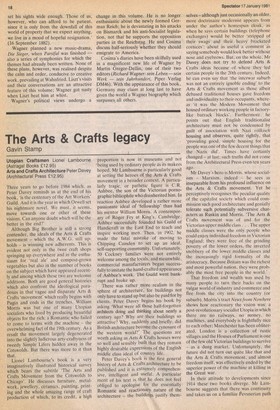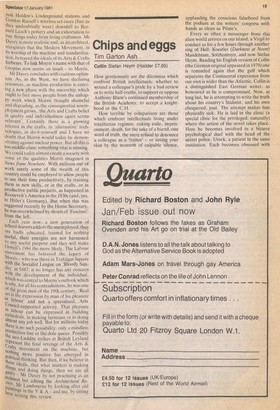The Arts & Crafts legacy
Gavin Stamp
Utopian Craftsmen Lionel Lambourne (Astragal Books £12.95) Arts and Crafts Architecture Peter Davey (Architectural Press £12.95).
Three years to go before 1984 which, as Peter Davey reminds us at the end of his book, 'is the centenary of the Art Workers' Guild. And it is the year in which Orwell set his nightmare novel. We must, it seems, move towards one or other of these visions. Can anyone doubt which will be the better in the end?'
Although Big Brother is still a strong contender, the ideals of the Arts & Crafts movement which the A.W.G. still upholds is winning new adherents. This is evident not only in the twee craft shops springing up everywhere and in the enthusiasm for 'real ale' and compost-grown vegetables but also in the number of books on the subject which have appeared recently and among which these two are welcome additions. Both are good general histories which also confront the ideological paradoxes in that vague and disparate Arts & Crafts 'movement' which really begins with Pugin and ends in the trenches. William Morris was but one of many Utopian socialists who lived by producing beautiful objects for the rich; a Romantic who failed to come to terms with the machine the overwhelming fact of the 19th century. As a result the movement largely degenerated into the slightly ludicrous arty-craftyness of tweedy Simple Lifers hidden away in the Cotswolds. But there was more to it than that.
Lionel Lambourne's book is a very imaginatively illustrated historical survey which bears the subtitle 'The Arts and Crafts Movement from the Cotswolds to Chicago'. He discusses furniture, metalwork, jewellery, ceramics, painting, printing and the whole amazing range of craft production of which, to its credit, a high proportion is now in museums and not 'being used by ordinary people as its makers hoped. Mr Lambourne is particularly good at setting the heroes of the Arts & Crafts movement in a broader context. A particularly tragic, or pathetic figure is C.R. Ashbee, the son of the Victorian pornographic bibliophile who disinherited him. In reaction Ashbee developed a rather more passionate ideal of 'fellowship' than had his mentor William Morris. A contemporary of Roger Fry at King's, Cambridge, Ashbee successfully founded his Guild of Handicraft in the East End to teach and inspire working men. Then, in 1902, he made the fatal mistake of moving to Chipping Camden to set up an ideal. self-supporting community. Unfortunately.
50 Cockney families were not entirely welcome among the locals, and meanwhile, cornmercial manufacturers began success fully to imitate the hand-crafted appearance of Ashbee's work. The Guild went bankrupt and broke up.
There was rather more realism in the sphere of architecture, for buildings not only have to stand up but also be paid for by clients. Peter Davey begins his book by asking 'What were all those half-forgotten architects doing and thinking about nearly a century ago'? Why are their buildings so attractive'? Why, suddenly and briefly, did British architecture become the cynosure of the western world?' The questions are worth asking as Arts & .Crafts houses were so well and sensibly built that they remain highly desirable expressions of the English middle class ideal of country life.
Peter Davey's book is the first general history of Arts & Crafts architecture to he published and it is extremely comprehensive, intelligent and useful. A particular merit of his text is that he does not feel obliged to apologise for the .essentially Romantic and reactionary nature of the architecture the buildings justify them selvesalthough just occasionally an older, more doctrinaire modernist appears from under the 'author's homespun, cloak, as when he says certain buildings (telephone exchanges) would he better 'stripped of their swags • and their heavy bracketed cornices': about as useful a comment as saying somebody would look better without nose and eyebrows. But, on the whole, Mr Davey does not try to defend Arts & Crafts ideas because of where they led certain people in the 20th century, Indeed, he can even say that 'the interwar suburb was not an entirely ignoble ending' to the Arts & Crafts movement as those albeit debased traditional houses gave freedom and individuality to their occupants, whereas 'it was the Modern Movement that housed ordinary working people in factory like barrack blocks'. Furthermore, he points out that English traditionalist architecture must not be condemned by guilt of association With Nazi vo/kisch housing and observes, quite rightly, that 'providing good, simple • housing for the people was one of the few decent things that the Nazis did'. Times have certainly changed at last; such truths did not come from the Architectural Press even ten years ago.
Mr Davey's hero is Morris, whose socialism Marxism. indeed he secs as inseparable from his profound influence on the Arts & Crafts movement. Yet he perceptively recognises the peculiar quality of the capitalist society which could com mission such good architect tire and genially tolerate such potentially subversive char acters as Ruskin and Morris. 'The Arts & Crafts movement was of and for the Victorian upper middle class. . . The upper middle classes were the only people who could enjoy individual freedom in Victorian England; they were free of the grinding poverty of the lower orders, the inverted snobbery of the lower middle classes and the increasingly rigid formality of the aristocracy. Because Britain was the richest and most powerful nation, they were probably the most free people in the world.'
That freedom and wealth was used by many people to turn their backs on the vulgar world of industry and commerce and flee from the city into the country (or suburb). Morris's tract News from Nowhere shows how reactionary the vision was: a post-revolutionary socialist Utopia in which there are no railways, no money, no machines. and everybody is frightfully nice to each other; Manchester has been obliterated, London is a collection of rustic villages and the Houses of Parliament is one of the few old Victorian buildings to survive as a dung market. Unfortunately, the future did not turn out quite like that and the Arts & Crafts movement, and almost freedom itself, was effectively ended by the superior power of the machine at killing in the Great war.
In their attitude to developments since 1914 these two books diverge. Mr Lambourne suggests that there was continuity and takes us on a familiar Pevsnerian path Past Holden's Underground stations and Gordon Russell's wireless set cases (fine its they undoubtedly were) downhill to Bernard Leach's pottery and an exhortation to buy things today from living craftsmen. Mr Davey is more realistic and, as an architect, recognises that the Modern Movement, in its worship of the machine and standardisation, betrayed the ideals of its Arts & Crafts forbears. To link Morris's name with that of Gropius now seems an insult — to Morris.
Mr Davey concludes with cautious optimism. As, in the West, we have declining resources, as machine production is entering a new phase with the microchip which Ought to free more people from the unhappy work which Morris thought shameful and degrading, as the consequential unemployment grows, 'the Arts and Crafts belief in quality and inelividualness again seems relevant'. Certainly there is a growing interest in the crafts, in 'alternative' technologies, in do-it-yourself and I have no doubt that Morris would today be demonstrating against nuclear power. But all this is too middle-class: something vital is missing. We could today almost create a society with some of the qualities Morris imagined in News from Nowhere. With millions out of work surely some of the wealth of this country could be employed to allow people to use their time productively, by training them in new skills, or in the crafts, or in productive public projects, as happened in Roosevelt's America in the 1930s (and, yes, in Hitler's Germany). But when this was suggested recently by the Home Secretary, he was overwhelmed by shouts of 'Fascism!' from the left.
Each year now, a new generation of school-leavers adds to the unemployed; they are badly :educated, trained for nothing useful, their energies are not harnessed
to any use purpose and they \yin make Orwell's 1984 the more likely. The Labour movement has betrayed the legacy of Morris — who was there in Trafalgar Square vvith the Socialist League on 'Bloody Sun'Y' in 1887; it no longer has any concern With the development of the individual, which was central to Morris's outlook which is why, for all his contradictions, he was One 01 the great men of the 19th century. 'Real .ari is the expression by man of his pleasure in labour' and not a specialised, Arts ouncil-supported activity. That pleasure in labour can be expressed in building cathedrals, in making furniture or in doing aLlnlost any job well. But for millions today tnere is no such possibility: only a mindless oduction line or the dole queue. Possibly neo-Luddite strikes at British Leyland ,rePresent the final revenge of the Arts & s-nrafts movement on the machine. hot ()thing more positive has emerged in ltical thinking. But then, if we believe in ideals, that what matters is making things and doing things. then we are all — Mr Davey by not practising as an avricehitect but editing the Architectural ReMr Lambourne by looking after old ,P,ritings in the V & A — and me, by sitting "cre writing this review.



































 Previous page
Previous page